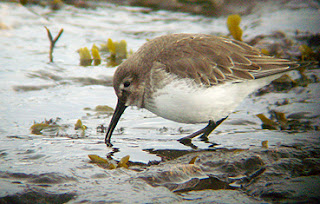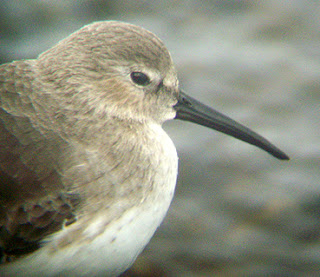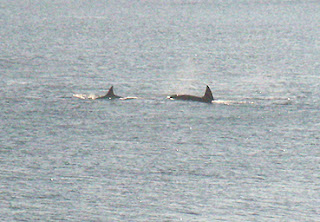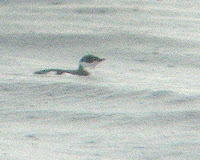We got up nice and early on Wednesday morning; destination
Babcock / Webb Wildlife Management Area. This huge chunk of land just northwest of Fort Myers, is primarily managed for hunting, but is famous in birding circles as one of Florida's best locations for finding the critically endangered
red-cockaded woodpecker.
We arrived on site, paid the paltry $3 per person and picked up a map from the reception office, and glanced at the tally of critters so far killed this season. This list included coyotes, racoons, doves and of course, 836
northern bobwhite. As one of the species I'd hoped to see, bobwhites are either so extremely common here that I'll have no trouble locating one, or there are now none left whatsoever...
 |
| Here be Red-Cockaded Woodpeckers |
We headed to the first
red-cockaded woodpecker cluster area - these woodpeckers are sociable birds and nest in close proximity to one another. The clusters are clearly marked by white stripes painted on the trees where the birds' nestholes can be found. Naturally, it's far out of breeding season and odds were somewhat stacked against our chances of finding any 'peckers at this time of year.
Nonetheless. we optimists pulled off the track and had a listen. A
northern flicker came through. Then a
red-bellied woodpecker stopped by. Then we heard the very un-woodpeckery sound of a red-cockaded as it flew across the track and through the trees. It was followed immediately by a second bird which kindly alighted on a tree right in front of us and showed brilliantly for a couple of minutes before it too vanished off in the distance. Result!
I couldn't believe my luck, barely out of the car for 5 minutes and my target bird was in the bag!
We then spent the next few hours stopping off at likely looking spots and seeing what we could find.
 |
| Little Blue Heron |
There were plenty of waterbirds around including
little blue herons (pictured),
sandhill cranes,
wood storks,
pied-billed grebes and
green herons,
great and
snowy egrets etc.
Glossy ibis made it on to the trip list courtesy of a small group of birds.
There were lots of
northern mockingbirds around, as well as many flocks of feeding
palm,
yellow-rumped and
pine warblers all over the place. A bit of pishing brought out some interesting birds including a showy and vocal
gray catbird.
Blue jays put in appearances, as did
eastern phoebes,
loggerhead shrikes and smart
eastern bluebirds. Hundreds of
tree swallows were hawking over the large grassy areas and small lakes.
 |
| Brit Birder in FL |
Red-shouldered hawks were the commonest raptor seen, plus we spotted occasional
Cooper's hawks and
northern harriers, as well as the ubiquitous
black and
turkey vultures.
A few shorebirds were seen in one particularly large wetland area. These included
killdeer, and around 70
greater yellowlegs and a single
lesser yellowlegs.
Stopping briefly to check out a warbler flock we heard the distinctive 'rubber-duck' calls of another key bird -
brown-headed nuthatch. Some careful, if panicked scrutiny of the feeding flock soon revealed one of these diminutive arboreal acrobats, which was soon joined by a second. They gave great views - always a bonus when seeing a lifer!
 |
| Alligator |
Alongside the birds, the park was also teeming with butterflies and dragonflies, plus we came across several
alligators (pictured). Paul, as driver, noted racoon and deer crossing the road in front of him, en route.
In several hours we only covered a fraction of the 65,758 acre area, but had seen a huge variety of habitat (and only one vehicle of gun-toting good ol' boys).
I didn't get to see any bobwhites, but hey-ho, they're widespread enough and I like to think that I may well see one somewhere else someday.
We arrived back on Gasparilla mid afternoon and Paul set off to the beach to do some fishing. We all joined him, and as we neared the beach the distinctive hoot of a
great horned owl was heard. Jenny, Satty and Paul carried on toward the water, while I dashed off in search of the vocal owl. It didn't take long, and I was soon looking up at a pair of great horned owls sat high in Banyan tree, one calling frequently. Very nice!
Once I joined the others on the beach, I scanned up and down taking in the numerous shorebirds present. Among the familiar
willets,
sanderlings and
black-bellied plovers there were also
white ibis,
great-blue heron and the usual
ring-billed and
laughing gulls. As I looked offshore, 3 juvenile
northern gannets were making a splash as they repeatedly dived into the water in their unmistakable manner.
Thursday
This morning Jenny and I spent the morning cycling around the north island. I had wanted to get a good look at the birds on the sand bars near the bridge, so I took my 'scope along with me.
Along the route we encountered the usual
palm warblers,
mourning doves,
Eurasian collared-doves,
ospreys,
American kestrels and the expected herons, egrets and
wood storks. An odd looking dove caught my eye sat on an overhead wire, and stopping to check it out I realised that it was a
white-winged dove.
Once we reached the bridge, we were relieved to see that the tide was low enough to expose a few small sandbars and thankfully there were birds feeding on them... scanning through I was pleased to see a good mix of waders;
willet,
red knot,
dunlin,
black-bellied plover and
semi-palmated plovers. However, the bird I really wanted to find (ever the optimist...) couldn't be seen.
 |
| Pelican, skimmers, terns... |
We crossed the road and checked out another sandbar on the other side.
Brown pelicans,
Sandwich terns,
Forster's terns, royal terns and
black skimmers were all present in good numbers (pictured).
Then I noticed right at the far end of the spit, some smaller birds. One
dunlin, 4
semi-palmated plovers, a
Wilson's plover and, hello... a pale plover, short bill, orange legs - Bingo! Another world first for me,
piping plover. I thought that this might be a long-shot, but it was the very species I was hoping for. Wonderful!
American white pelicans were gliding overhead, while the ever-present
ospreys kept us entertained with their nest building and highly successful fishing forays. My first
reddish egret of the trip was fishing the shallows, flanked by a
little blue heron. A juv
bald eagle was sat up in a dead tree.
A sizeable flock of
palm warbler were feeding in the same roadside trees as they were a couple of days ago, and once again a single
pine warbler and a
black-and-white warbler were among them.
We headed back to 'town' and after a cuppa we headed to the beach to catch up with Paul and Satty.
 |
| Great horned owl |
On the way, we stopped off to see if the
great horned owls were still in the big banyan. They were, and we got a few shots of one of the birds as it sat high in the canopy.
On the beach, it was mainly business as usual.
As Jen and I walked along the length of the beach, we encountered more birds as we got further from the developed areas and here we found good numbers of
dunlin,
western sandpiper and
red knot (pictured) as well as the familiar
ruddy turnstone and other common tideline dwellers.
 |
| Red Knot |
Paul's highlight of the day was catching a clear nosed skate, a rather charming fish which, when released, partially buried itself in the sand within inches of the water line. Eventually it realised that this wasn't the best place to be and swam off unharmed, if a little traumatised!













































